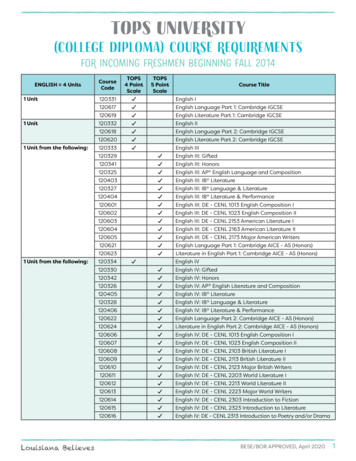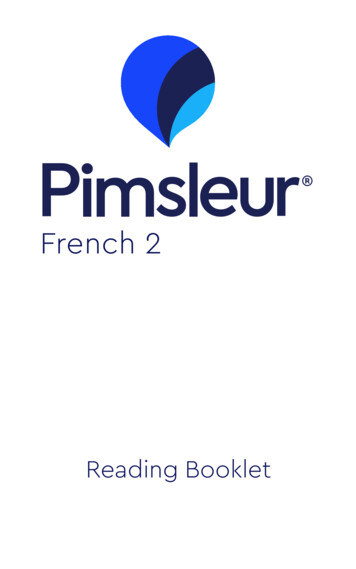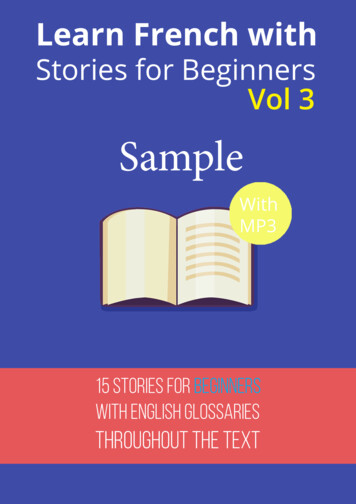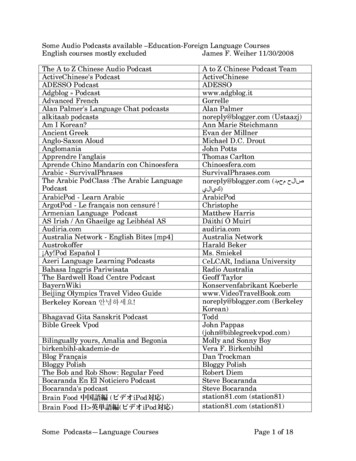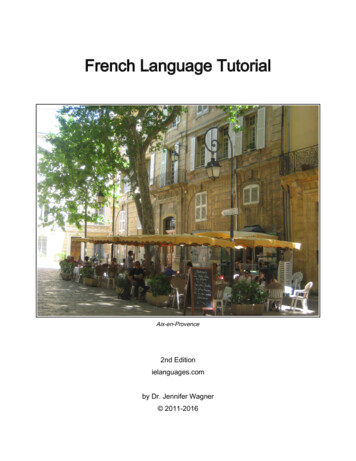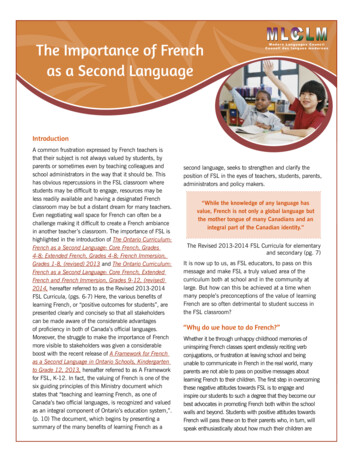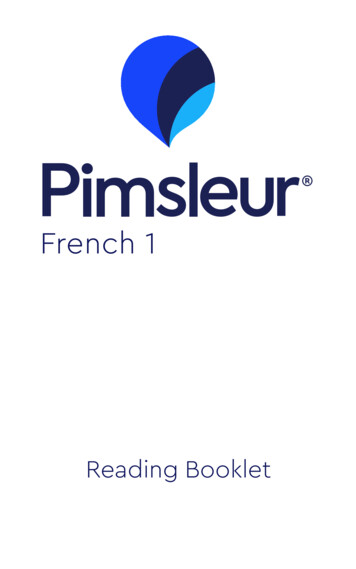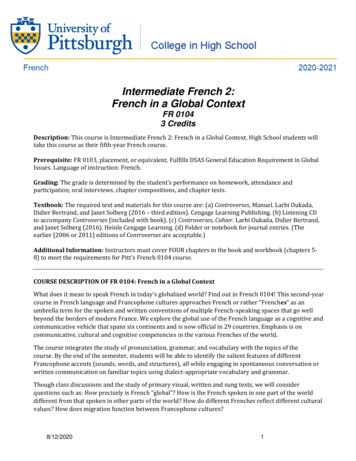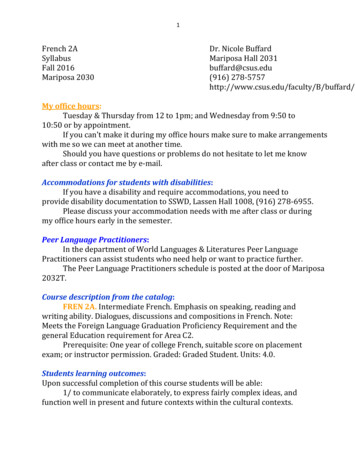
Transcription
The Praxis Study CompanionFrench:World Language(5174)www.ets.org/praxis
Welcome to the Praxis Study CompanionWelcome to the Praxis Study CompanionPrepare to Show What You KnowYou have been working to acquire the knowledge and skills you need for your teaching career. Now you areready to demonstrate your abilities by taking a Praxis test.Using the Praxis Study Companion is a smart way to prepare for the test so you can do your best on test day.This guide can help keep you on track and make the most efficient use of your study time.The Study Companion contains practical information and helpful tools, including: An overview of the Praxis tests Specific information on the Praxis test you are taking A template study plan Study topics Practice questions and explanations of correct answers Test-taking tips and strategies Frequently asked questions Links to more detailed informationSo where should you start? Begin by reviewing this guide in its entirety and note those sections that you needto revisit. Then you can create your own personalized study plan and schedule based on your individual needsand how much time you have before test day.Keep in mind that study habits are individual. There are many different ways to successfully prepare for yourtest. Some people study better on their own, while others prefer a group dynamic. You may have more energyearly in the day, but another test taker may concentrate better in the evening. So use this guide to develop theapproach that works best for you.Your teaching career begins with preparation. Good luck!Know What to ExpectWhich tests should I take?Each state or agency that uses the Praxis tests sets its own requirements for which test or tests you must take forthe teaching area you wish to pursue.Before you register for a test, confirm your state or agency’s testing requirements at www.ets.org/praxis/states.How are the Praxis tests given?Praxis tests are given on computer. Other formats are available for test takers approved for accommodations (seepage 52).The Praxis Study Companion2
Welcome to the Praxis Study CompanionWhat should I expect when taking the test on computer?When taking the test on computer, you can expect to be asked to provide proper identification at the testcenter. Once admitted, you will be given the opportunity to learn how the computer interface works (how toanswer questions, how to skip questions, how to go back to questions you skipped, etc.) before the testing timebegins. Watch the What to Expect on Test Day video to see what the experience is like.Where and when are the Praxis tests offered?You can select the test center that is most convenient for you. The Praxis tests are administered through aninternational network of test centers, which includes Prometric Testing Centers, some universities, and otherlocations throughout the world.Testing schedules may differ, so see the Praxis web site for more detailed test registration information at www.ets.org/praxis/register.The Praxis Study Companion3
Table of ContentsTable of ContentsThe Praxis Study Companion guides you through the steps to success1. Learn About Your Test .5Learn about the specific test you will be taking2. Understanding Question Types . 13Become comfortable with the types of questions you’ll find on the Praxis tests3. Practice with Sample Test Questions . 15Answer practice questions and find explanations for correct answers4. Determine Your Strategy for Success . 43Set clear goals and deadlines so your test preparation is focused and efficient5. Develop Your Study Plan . 46Develop a personalized study plan and schedule6. Review Smart Tips for Success . 50Follow test-taking tips developed by experts7. Check on Testing Accommodations . 52See if you qualify for accommodations to take the Praxis test8. Do Your Best on Test Day . 53Get ready for test day so you will be calm and confident9. Understand Your Scores . 55Understand how tests are scored and how to interpret your test scoresAppendix: Other Questions You May Have . 57The Praxis Study Companion4
Step 1: Learn About Your Test1. Learn About Your TestLearn about the specific test you will be takingFrench: World Language (5174)Test at a GlanceTest NameFrench: World LanguageTest Code5174TimeApproximately 3 hours, including the Listening Practice section and optionalpractice with the built-in character toolbar for the Writing section.Number of Questions75 selected-response questions and 6 constructed-response questionsFormatListening Practice section (not scored). Listening with cultural knowledge;6 selected-response questions (10 minutes)Section 1. Listening with Cultural Knowledge; 36 selected-response questions(50 minutes)Section 2. Reading with Cultural Knowledge; 39 selected-response questions(50 minutes)Writing Practice (not scored). One practice constructed-response exerciseusing the built-in character toolbar (5 minutes)Section 3. Writing, with 3 constructed-response tasks (50 minutes)Section 4. Speaking, with 3 constructed-response tasks (15 minutes)Note: This test will include questions with an audio component in the Listeningand Speaking sections.Test DeliveryComputer deliveredContent CategoriesVIApproximateNumber ofQuestionsApproximatePercentage ofExaminationI.IVInterpretive Listening, includingembedded linguistic content30 selected response26%II.IIIIIInterpretive Reading, includingembedded linguistic content30 selected response26%15 selected response12%IV. Interpersonal and PresentationalWriting3 constructed response(written responses)18%V.3 constructed response(spoken responses)18%III. Cultural Knowledge(Tested in Sections 1 and 2)The Praxis Study CompanionPresentational and InterpersonalSpeaking5
Step 1: Learn About Your TestAbout This TestThis test is designed to measure the knowledge, skills,and abilities of examinees who have had preparationin a program for teaching French in grades K–12.Because programs in teaching French are offered atboth the undergraduate and graduate levels, this testis appropriate for examinees at either level. All sectionsof this test are at the Advanced Low level, as describedin the proficiency guidelines of the American Councilon the Teaching of Foreign Languages (ACTFL).This test integrates listening, reading, writing, andspeaking skills, as well as linguistic and culturalknowledge, through active participation in a variety ofquestions in the interpretive modes (in the Listeningand Reading sections) and in the interpersonal andpresentational modes (in the Writing and Speakingsections). The Listening and Reading sections of thetest are composed of selected-response questions,whereas the Writing and Speaking sections arecomposed of constructed-response tasks.All questions and answer choices are in French andare based on various genres of authentic material,whether written or in audio format, from variousFrench-speaking regions of the world.This is a computer-based test with sections of variouslengths and time constraints. All sections of the testare separately timed. While the time allotted in theReading and Writing sections is managed by thecandidate, timing is computer-controlled throughoutthe Listening and Speaking sections. Before beginningthe Listening section, the candidate will participatein a practice exercise reflecting the type of questionsin the Listening section. Similarly, there is a writingpractice exercise before the Writing section toacquaint candidates with a special character toolbarthat they will be using to type their individualresponses in French.This test may contain some questions that do notcount toward your score.Discussion AreasInterspersed throughout the study topics arediscussion areas, presented as open-ended questionsor statements. These discussion areas are intended tohelp test your knowledge of fundamental conceptsand your ability to apply those concepts to situationsThe Praxis Study Companionin the classroom or the real world. Most of the areasrequire you to combine several pieces of knowledgeto formulate an integrated understanding andresponse. If you spend time on these areas, you willgain increased understanding and facility with thesubject matter covered on the test. You may want todiscuss these areas and your answers with a teacher ormentor.Note that this study companion does not provideanswers for the discussion area questions, but thinkingabout the answers to them will help improve yourunderstanding of fundamental concepts and willprobably help you answer a broad range of questionson the test.Content TopicsAn overview of the areas covered on the test, alongwith their subareas, follows.I.Content Categories I, II, IV, and V –Language, Linguistics, and Comparisons(88%)A.Demonstrating language proficiency—communication in the target languagewith native speakers unaccustomed tointeracting with nonnative speakers, withsufficient accuracy, clarity, and precisionto convey intended message. (At theAdvanced Low level, as described in theAmerican Council on the Teaching ofForeign Languages [ACTFL] ProficiencyGuidelines)The beginning French teacher:1. Knows how to communicate in the targetlanguage with native speakers unaccustomedto interacting with nonnative speakers, withsufficient accuracy, clarity, and precision toconvey the intended message2. Knows how to communicate in theinterpersonal mode (speaking) byparticipating actively in informal and formalconversations on topics covering home,school, leisure activities, and current events3. Knows how to communicate in theinterpersonal mode (writing) in writtenexchanges on daily topics6
Step 1: Learn About Your Test4. Comprehends in the interpretive mode(listening) main ideas and supporting detailsof audio segments, such as news items, shortstories, social notices, and reports on familiartopics that deal with factual information5. Comprehends in the interpretive mode(reading) main ideas and supporting detailsof printed texts, such as news items, shortstories, social notices, and reports on familiartopics that deal with factual information6. Knows how to negotiate meaning in order tosustain an interaction7. Knows how to move beyond literalcomprehension in the interpretive mode(listening) by inferring the meaning ofunfamiliar words and phrases in newcontexts, inferring and interpreting theauthor’s intent, and offering a personalinterpretation of the message8. Knows how to move beyond literalcomprehension in the interpretive mode(reading) by inferring the meaning ofunfamiliar words and phrases in newcontexts, inferring and interpreting theauthor’s intent, and offering a personalinterpretation of the message9. Understands the gist of normalconversational speech on a variety of topics10. Knows how to communicate in thepresentational mode (writing) by writingroutine social correspondence, as well ascoherent narratives, descriptions, andsummaries about familiar topics of a factualnature in paragraph length in present, past,and future tense11. Knows how to communicate orally in thepresentational mode (speaking) by deliveringoral presentations on familiar literary orcultural topics and incorporating extralinguistic support to facilitate oralpresentations that are extemporaneous orprepared but not readB.Understanding linguistics—linguisticfeatures of the target languageThe beginning French teacher:1. Understands the rules of the sound system ofthe target language (i.e., recognizingphonemes and allophones)The Praxis Study Companion2. Recognizes key cohesive devices(conjunctions and adverbs) used inconnected discourse3. Understands high-frequency idiomaticexpressions and can infer meaning of wordsand sentences4. Knows how to explain the rules that governthe formation of words and sentences in thetarget language5. Knows how to exemplify the rules withexamples from the target language, such asthe verb structures and verb tenses,pronouns, agreement (such as subject/verb,adjective/noun), word order, andinterrogatives, both in terms of regularitiesand irregularities6. Knows how to identify and use the pragmaticand sociolinguistics conventions and register(formal and informal forms of address)C.Comparing the target language withEnglishThe beginning French teacher:1. Knows how to identify similarities anddifferences between the target language andEnglish2. Knows how to contrast syntactical patterns ofsimple sentences and questions in the targetlanguage with those of EnglishDiscussion areas: Content Categories I,II, IV, and V – Language, Linguistics, andComparisons What strategies should be used wheninterpreting implicit meaning in a listening orreading stimulus in a given context? What criteria determine the use ofappropriate register in interpersonal speakingand writing communication? How can one familiarize oneself with regionallinguistic variations often encountered inauthentic documents? What strategies could be implemented tomaster the use of vocabulary, idiomaticexpressions, and grammatical structures (i.e.,verb tenses, pronouns, adjectives, adverbs,etc.) of the target language?7
Step 1: Learn About Your TestII. Content Category III – Cultures, Literatures,and Cross-disciplinary Concepts (12%)A.Demonstrating cultural understanding—connections among the perspectives ofthe target culture and its practices andproductsThe beginning French teacher:1. Knows the three Ps:a.perspectives (such as attitudes, ideas,and values)b.practices (patterns of behavior and socialinteraction, such as greetings, turntaking, and rites of passage)c.products (such as architecture, literature,art, foods, and music)2. Recognizes the value and role of authenticliterary and cultural texts—such as songs,poems, rhymes and chants, children’s books,narrative text, and novels—and usage ofthose texts to interpret and reflect on theperspectives of the target culturesDiscussion area: Content Category III –Cultures, Literatures, and Cross-disciplinaryConcepts What are some important cultural aspects(i.e., social, cultural, artistic, etc.) that helpinform one’s understanding of the targetculture?Cultural Knowledge TopicsThe following is a suggested list of topics that mayappear in the Cultural Knowledge segment of the test.This list is in no way comprehensive, but it provides anidea of the type of topics related to the diverse culturesof the Francophone world that may appear in the test.Lifestyles and SocietiesIn these questions, your knowledge of the way of life andcustoms in the Francophone world will be tested. Contemporary lifestyles Food Social behaviors and customs Commonly celebrated religious and publicholidays Education Regional variationsSociolinguistic Elements of FrenchThese questions test your knowledge and understandingof appropriate language and expressions. Based onthe language in a selection, it may require you to makeinferences regarding social situations or the audience. Customary usage of certain words or expressionsto indicate register, such as the use of vous asopposed to tu Idiomatic expressions; common sayingsLiterature and the ArtsFor these questions, you should acquaint yourself withthe most commonly known works, authors, and trends inthe Francophone world. Major trends, periods and movements inFrancophone literature. Examples: la Littératuremédiévale, la Renaissance, le Classicisme, lesLumières, le Romantisme, le Réalisme, leDadaisme, la Négritude, le Surréalisme,l’Existentialisme, le Nouveau Roman. Significant figures, works, and trends in theplastic arts (painting and sculpture). Examples:Basquiat, David, Gauguin, Magritte, Manet,Matisse, Monet, Rodin, Saint-Laurent. Architecture in the Francophone world.Examples: Le style Gothique, Baroque, ArtNouveau. Famous musical composers, singers fromclassical to modern era. Examples: Amadou etMariam, Berlioz, Debussy, Messiaen, N’Dour,Ravel.STEM (Science, Technology, Engineering,Mathematics) Significant scientific figures. Examples: Diop,Lamarck, Pasteur, Curie, Yazami. Major technological advances. Examples: lesexosquelettes, la robotique, la voiture autonome. Influential figures in engineering. Examples:Daguerre, Eiffel. Famous contributors to the world ofmathematics. Examples: Benmalek, Ben Salem,Descartes, Pascal. Family relationships VacationsThe Praxis Study Companion8
Step 1: Learn About Your TestHistoryIn these questions, your knowledge of the historicalfacts and background of the Francophone world will betested. This includes: Traditional or mythic ancestry (les Gaulois) French colonization and decolonization Contributions of French culture to the world Relations with other EU countries Immigration issues in France Most important events and principal historicfigures of the Francophone world Contemporary world politics and economics asthey relate to the Francophone world (e.g., tradeagreements)La FrancophonieYou should be acquainted with the concept offrancophonie and broad general information about theFrancophone world, including the DOM-TOM, inTest SectionsThe Listening Practice section, Section 1 (Listening)and Section 4 (Speaking) are recorded. For Section 4,you must answer the questions when instructed to doso on the recording. Descriptions of the test sectionsare provided below.Listening Practice Section - InterpretiveMode: Listening with Cultural KnowledgeThis section allows you to listen to an audio selectionin French and to practice answering questionsbased on that selection in the time allotted. ThisListening Practice section is timed separately fromthe Listening section that follows, and the time youspend practicing will not be counted toward the timeallotted to answering the questions in the Listeningsection. The questions in this section will NOT bescored and will NOT affect your results in any way. EuropeSection 1 - Interpretive Mode: Listeningwith Cultural Knowledge North AmericaThe selections in Section 1 are recorded. The Caribbean Africa AsiaGeographySometimes a culture question may involve locatingFrench-speaking regions and countries, including theDOM-TOM, or identifying major geographical featuressuch as major cities, rivers, or mountains in Europe North America The Caribbean Africa AsiaOnce again, test takers are reminded that these aresimply areas, topics, events, and figures that representthe major categories that are covered.In this section, you will hear a variety of selections,such as radio broadcasts, narratives, and dialogues, inFrench. Each selection is followed by six questions.Each selection will be played twice. You will hearthe selection and then you will have 60 seconds topreview the questions before the selection plays asecond time. For each question, choose the responsethat is best, relative to the selection. The last twoquestions may test your knowledge of culture andlinguistics. You may take notes as you listen. Yournotes will not be graded.After listening to a selection the second time, you willsee six questions presented one at a time. You willhave 20 seconds to answer each question. A clock atthe top of the screen will indicate how much time isremaining to answer the question. The entire Listeningsection lasts approximately 50 minutes.When the response time has ended, you willautomatically be taken to the next question. You willnot be able to return to previous questions.The Praxis Study Companion9
Step 1: Learn About Your TestSection 2 - Interpretive Mode: Reading withCultural KnowledgeIn this section, you will be presented with a varietyof selections, such as newspaper articles, excerpts ofliterary passages, and other materials, in French. Eachselection is followed by six questions. The last twoquestions may test your knowledge of culture andlinguistics. In addition, you will be presented withsome visual stimuli (e.g., photographs or works of art),each accompanied by a single cultural knowledgequestion.Additionally, if your security settings are set very high, asecond security prompt asks you to run the application.Again, this is normal. When this prompt appears, clickRun.If you are unsure if your computer has Java RuntimeEnvironment version 8u281, navigate to Start/ControlPanel/Java. From the Java Control Panel popup window,select the Java tab, then the View button. The JavaRuntime Environments Setting window displays thecurrently installed versions of Java.You may take notes as you read, but only on thescratch paper that will be provided. Your notes will notbe graded.You may use the scratch paper that will be providedto take notes on each task. These notes will not beused in evaluating your response.Each of the questions is followed by four suggestedanswers. Select the one that is best in each case.Your writing will be evaluated on the following:Cultural Knowledge The culture questions are in French and are partof Section 1 (Listening) and Section 2 (Reading). Questions focus on connections among theperspectives of the target culture and itspractices and products.Section 3 - Interpersonal and PresentationalWritingThere are three tasks in this section. Be sure tocomplete each task. Please pace yourself as you work.Type your answers in French in the space provided.For French-specific characters (e.g., ç, é, à, î, etc.), usethe built-in character toolbar (view a demo of thetoolbar). You should give as complete a response aspossible. Your written French should be acceptable toa wide range of native speakers.Note: To run the built-in character toolbar demo fromthe preceding link, you need Java Runtime Environmentversion 8u281 installed on your computer. If you do nothave Java Runtime Environment version 8u281, you candownload it for free or you can visit the Java websiteto install it. To avoid issues with the download, be sureto uninstall all Java versions in your system and rebootyour computer before downloading version 8u281. Whenyou click on the tutorial link below, a security promptmay ask you to allow the program to run. This is normal.The toolbar tutorial runs the same version of Java that ison the actual test to ensure that the tutorials accuratelyreflect the testing experience. When the prompt appears,click Allow (or Keep).The Praxis Study Companion Overall comprehensibility to a native speaker ofFrench who is not accustomed to the writing ofnonnative learners Accuracy and appropriateness of content Presentation of ideas in a related and logicalmanner Appropriateness of vocabulary Accuracy of grammar and mechanics (includingspelling and diacritical marks) Cohesiveness (including use of varied sentencestructure and transitional expressions whereappropriate) Appropriateness for a given task and/or reader(register) The extent to which each task is completedInterpersonal Writing: Response to anE-mail, Memo, or LetterYou will be given an e-mail, memo, or letter to whichyou will write an appropriate response in French. First,read the e-mail, memo, or letter. Then, write yourresponse in the space provided.Manage your time to allow for planning, writing, andrevising your response. The length of your responseshould be at least 60 words.Presentational Writing: Opinion/PositionEssayYou will be asked to write an essay in French on aspecific topic. First, read the topic. Then, write yourresponse in the space provided.10
Step 1: Learn About Your TestMake sure that your essay includes reasons and/orexamples to support your opinion.Manage your time to allow for planning, writing, andrevising your response. The length of your responseshould be at least 120 words. Accuracy of grammar and pronunciation Fluency of delivery and cohesiveness (includinguse of varied sentence structure and transitionalexpressions where appropriate) Appropriateness for a given task and/or listener The extent to which each task is completedPresentational Writing: Integrated SkillsYou will read a passage in French. This passage willappear in both the Writing and the Speaking sections.After reading the passage, you will complete a writingtask based on the passage. Your response must bewritten in French. Write your response in the spaceprovided.Manage your time to allow for planning, writing, andrevising your response. The length of your responseshould be at least 120 words.Section 4 - Presentational and InterpersonalSpeakingThis section includes three tasks and is designed tomeasure different aspects of your ability to speakFrench. Although you need not speak for the entiretime allotted, you should give as complete a responseas possible.For each speaking task in the test, you will be giventime to prepare your response and time to record yourresponse. A tone will indicate when to begin speaking,and a clock on your screen will indicate how muchtime you have left.Begin speaking only when the voice on the recordingdirects you to respond; you will not be given creditfor anything recorded during the preparation time.As you speak, your response will be recorded. Yourscore for these tasks will be based only on what is onthe recording. It is important that you speak loudlyenough and clearly enough into the microphone.Your speaking will be evaluated on the following: Overall comprehensibility to a native speaker ofFrench who is not accustomed to interactingwith nonnative speakers Accuracy and appropriateness of the content Presentation of ideas in a related and logicalmannerIf you do not know specific vocabulary, try to expressyourself as well as you can, using circumlocution ifnecessary. If you make a mistake and correct it soonafterward, it will not be considered a mistake. Youmay take notes only on the scratch paper that will beprovided. These notes will not be used in evaluatingyour responses.Presentational Speaking: Integrated SkillsYou will be asked to speak on a topic related to thepassage you have already read.First, you will have 15 seconds to read these directions,and then you will hear the topic and the requirementsfor your response. You will have 3 minutes to reviewthe passage and prepare your response. Then you willhave 2 minutes to record your response in French.A clock will indicate how much time is remaining toplan your answer and to record your response.A tone will indicate when you should begin speaking.You should respond as fully and as appropriately aspossible. When the response time has ended, you willautomatically be taken to the next task. You will notbe able to return to the previous sections.Presentational Speaking: Express anOpinion or Make an Oral PresentationYou will be asked to give an oral presentation on aspecific topic. First, you will have 15 seconds to readthese directions, and then you will hear the topic foryour presentation.You will have 2 minutes to prepare your response.Then, you will have 2 minutes to record your responsein French.A tone will indicate when you should begin speaking.A clock at the bottom of the screen will indicate howmuch time is remaining to plan your answer and torecord your response. You should respond as fully andas appropriately as possible. Appropriateness of vocabularyThe Praxis Study Companion11
Step 1: Learn About Your TestWhen the response time has ended, you willautomatically be taken to the next task. You will notbe able to return to the previous task.Interpersonal Speaking: SimulatedConversationYou will participate in a simulated conversation withina context in French. First, you will have 30 seconds toread the outline of the conversation. In each pair oflines, the first line gives you an idea of what you willhear, and the second, bolded line gives you an idea ofwhat you will be expected to say.You will have five turns to participate in theconversation. A tone will indicate when you shouldbegin speaking. Each time it is your turn, you will have25 seconds to respond. You should participate in theconversation as fully and as appropriately as possible.A clock at the bottom of the screen will indicate howmuch time is remaining to answer the question.When the response time has ended, you willautomatically be taken to the next question. You willnot be able to return to previous questions.The Praxis Study Companion12
Step 2: Understanding Question Types2. Understanding Question TypesBecome comfortable with the types of questions you’ll find on the Praxis testsThe Praxis assessments include a variety of question types: constructed response (for which you write aresponse of your own); selected response, for which you select one or more answers from a list of choices ormake another kind of selection (e.g., by selecting a sentence in a text or by selecting part of a graphic); andnumeric entry, for which you enter a numeric value in an answer field. You may be familiar with these questionformats from taking other standardized tests. If not, familiarize yourself with them so you don’t spend timeduring the test figuring out how to answer them.Understanding Selected-Response and Numeric-Entry QuestionsFor most questions, you respond by selecting an oval to select a single answer from a list of answer choices.However, interactive question types may also ask you to respond by: Selecting more than one choice from a list of choices. Typing in a numeric-entry box. When the answer is a number, you may be asked
French: World Language (5174) Test at a Glance. Test Name French: World Language Test Code 5174 Time Approximately 3 hours, including the Listening Practice section and optional practice with the built-in character toolbar for the Writing section. Number of Questions 75 selecte
